Outside of the car-enthusiast community, many people think of a car wash and car detailing as the same thing. The difference only sinks in when they hear the price tag of a car detail. The average consumer may wonder if auto detailing is an essential service, or an expensive luxury for car fanatics.
Maybe you noticed your trusty auto was a little dusty and worse for wear. Skeptical of those automated “hands-free” car wash robots behind gas stations, you rolled up to a professional hand car wash and asked for the $12 “basic wash.”
You know it’s coming. You try to will it away. But the attendant does his or her job and goes for the upsell: “Would you like to upgrade to a full car detail for just $100 more?”
Oof. You had other plans for that $100. What are they selling you? Is auto detailing really worth it?
What is Car Detailing?
Car detailing is more than just a “car wash.” Whereas a wash gets your car superficially cleanerand more presentable, car detailing or auto detailing is the process of cleaning and reconditioning your car from top to bottom, front to back, inside and out.
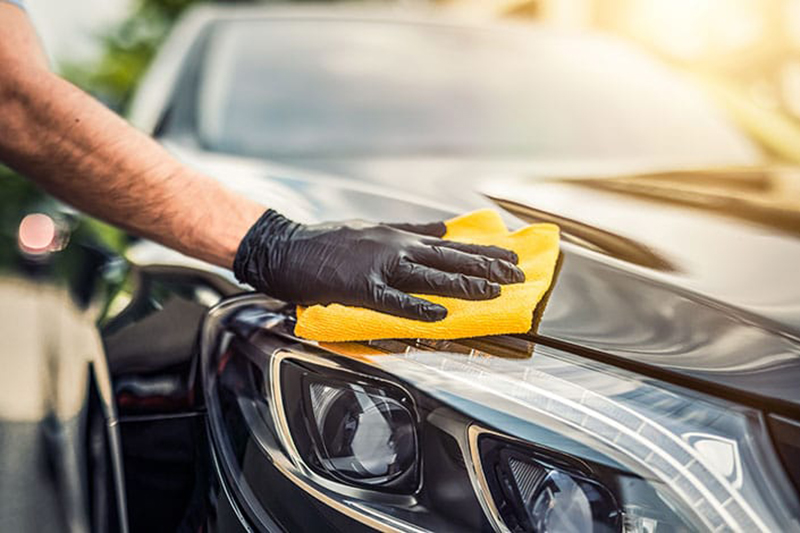
While it doesn’t need to happen every week or even every month, every car owner should get their vehicle detailed a few times a year to protect their investment and keep their car in the best condition possible for as long as possible.
How is Auto Detailing Different from a Car Wash?
A hand car wash wipes the dirt off the surfaces of your car so it doesn’t look like a rolling version of Pigpen from Peanuts. This can be done in 30 or 40 minutes.However, a car wash only addresses your car’s cleanliness at the most superficial level. Auto detailing not only cleans your car deeply, but restores many components and protects it from further harm.

Think of it as the difference between a quick shower and a full day at the spa, complete with massages, pore cleansing, scrubs, and peels. You leave the shower feeling presentable. You leave the spa feeling like a whole new person.
Car detailing is like a spa day for your car, from which it emerges rejuvenated and ready to make a meal out of the road with you in the driver’s seat.
What are the steps of Auto Detailing?
A car detail is much more extensive than a car wash. Depending on your car’s needs, auto detailing will entail some, most, or all of the following:
Exterior Car Detailing
- Removal of dirt and mud using specialized soaps and foams.
- Scrubbing the wheels, including brake calipers and lug nuts, with specialized products.
- Surface washing with microfiber towels and washing mitts.
- Removal of deeply-embedded dirt from the clear coat using an automotive clay bar.
- Polishing of the paint, either by machine or by hand, to remove scratches, swirls, and oxidation.
- Application of protective wax, either synthetic or carnauba-based, which also gives the car a “like-new” shine.
- Cleaning of windows and rubber surfaces.
- Finishing touches on the trim and details to make the car sparkle.
Interior Car Detailing
- Vacuuming of the carpet and upholstery to remove dirt and debris.
- Shampooing the carpet and upholstery to deep-clean and remove stains.
- Conditioning and scrubbing of any leather surfaces to remove deeply-embedded dirt.
- Cleaning and dressing of vinyl and plastic surfaces.
- Cleaning and polishing of interior glass.
Engine Detailing
- Light spraying of the engine bay with water.
- Application of a degreaser to exposed engine components.
- Rinsing with another light spray of water.
- Proper drying of all plastic, rubber, and silicone surfaces to prevent cracking.
How much does Auto Detailing Cost?
When weighing a wash versus a detail, the sticker price punches many consumers’ tag. They thought their car was looking a little dingy, but they didn’t get out of bed expecting to sink $100 or more on their car. It didn’t throw a tire or anything—it just needs to be spruced up a little!
A basic hand car wash can run between $20 and $70 depending on the services and add-ons. Car detailing is much more thorough, time-consuming, material-intensive, and costs more.The size of the vehicle makes a difference, but in general, an auto detailing job will run you anywhere from $50 to $150 or more. Extra services like leather treatment or clay bar plucking may bump up the price tag as well.
When shelling out for an auto detail, it helps to look at the big picture. Your car is a long-term investment. It may not be rotting apart on its axles today, but regular protective services like car detailing help prevent that fateful day from coming too soon.
Mobile Car Detailing
Car detailing takes anywhere from 90 minutes to three hours or more. Busy people may not have time to cool their heels in a customer lounge or nearby cafe for that amount of time. With errands to run, work to do, children to mind, Netflix to watch … the option of a mobile detailing service can be very attractive.
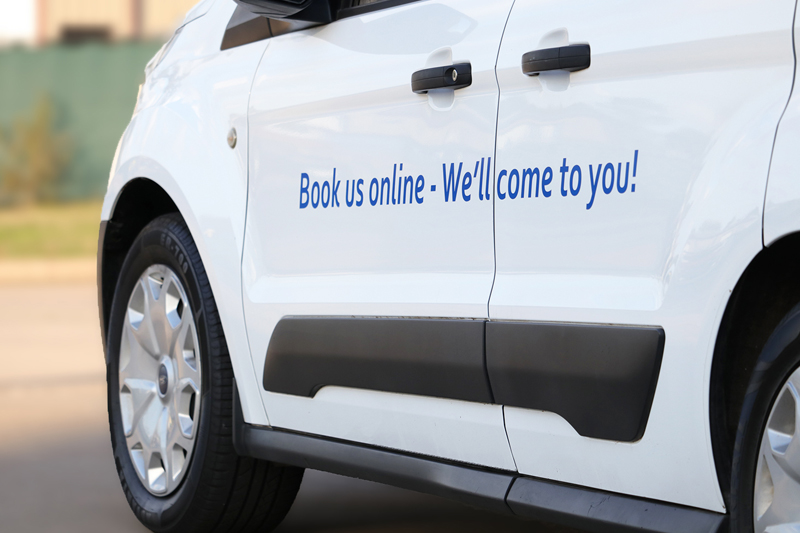
Rather than taking your car to the detailing shop, mobile detailing professionals come to your car wherever it is—your driveway, your office parking lot, etc. They bring portable detailing equipment and restore your car while you go about your business.
Of course, you will pay extra for this convenience. Expect prices to start at $50 and go up from there. However, for many professionals, time is money, including the time it takes to drive to and from the detailing shop.
We can always make more money, but we can’t invent more hours in the day. If you never have enough time to finish your work, spend on loved ones and hobbies, or just relax and decompress, having your car detail team come to you might be worth every penny.
Why get your Car Detailed?
Despite the sticker shock, there are many great reasons to get your car detailed sooner rather than later, including …
Pride In Your Car
Many of us spend a lot of time in our car, getting to know its quirks and character. Even if we aren’t “car people,” we feel a deep affection for our cars and their roles in our lives.How we treat our most prized possessions says something not only about our pride in them, but our pride in ourselves. Why not be the kind of person who meets the world in a spotless car?
Maintain your Car’s Value
If you expect to sell or trade in your car in the future, regular detailing can stave off preventable defects that reduce the car’s market value. Auto detailing is also critical to maintain the value of classic cars.
Protect Your Automobile Investment
Our cars take a beating on the road. Extra steps included in a car detail job, like waxing, protect it from the elements, not only preserving its value but making sure it lasts longer without costly replacements or inconvenient breakdowns.
Don’t Miss the Details
Every car is different. A car wash does not address your car’s unique needs. Auto detailing offers a personal touch and a chance for a car professional to recommend customized solutions to keep your baby tip-top.
How to choose a Car Detailing Service
If you live in a large town, you may have many options of car detailing service providers to choose from. Before entrusting your car (and your money) to one of them, do some research. Look into …
Services
Car detailing is not a “one-size-fits-all” service. Does the detailing professional approach each car as its own project, with its own unique issues and problems to solve? Does the detailer offer specialty services you might be looking for, like claying, synthetic waxing, dog hair removal, or engine degreasing?
Reviews
It’s easier than ever for car detailers with a good reputation to rise to the top. Look on consumer review sites like Yelp.com, or at the reviews posted for the detailing company on their Google My Business entry (found in the “Google Map” section of your Google search).
Ask around for recommendations from friends, family, and colleagues. Facebook makes it easy to make a post asking your social network for recommendations.
Mobility
Would you prefer a mobile car detailing service? Find out if the provider offers mobile detailing services and how scheduling works.
Price
Finally, if you are on a budget, shop prices a little bit, making sure to take note of what desirable services might disappear from the scope of work at lower price points.
How to Wash Your Car the Right Way
Maybe you have more time than money. Maybe you love the meditative act of caring for your car. Maybe you just don’t like handing the keys to your baby over to a stranger. For whatever reason, you have decided to skip the detailing job and clean your car yourself. DIY car washing and car detailing can be both economical and pleasurable.
It’s the zen satisfaction of shutting out all other cares and focusing on a meaningful task; the symbolic act of degreasing your mind and washing your cares away with the dirt on your car. It takes more than just a garden hose. Here’s how to properly clean your car …
Avoid Do-It-Yourself Car Washing Bays
You may have used or at least seen do-it-yourself car washing stalls, armed with a handy hose-brush tool that dispenses lather, polish, and water with the turn of a dial. Easy, right?
Unfortunately, those brush tools accumulate dust and dirt with each successive wash. This dirt tends to scratch your car’s paint job at the same time as it removes surface dirt. Additionally, that hose-brush just does not have enough functions to make a real difference. True car-care enthusiasts are better off without them.
Evaluate the Scope of the Job
Look the car over from tip to stern. Be honest about what it needs. Is it in pretty good shape and just in need of a touch-up? Or has it been ages since it had some TLC? If you haven’t had your car detailed in ages (or ever), you may want to invest in automotive clay, wax, and polish to give the car the most fresh start possible.
Read the labels of your Cleaning Products
Use the right product for the right job. A product good for your car’s wheels might eat away at the paint job. Read labels and get new cleaning products if needed. It’s not worth the risk if you end up scarring your car while trying to clean it.
The Three-Bucket System
If you only have one bucket, get two more. The three-bucket system is a time-honored approach to washing your car.The point is to avoid slathering your car’s grit and grime right back on it by continually dunking your rags or mitts into a single bucket of water, making your cleaning solution dirtier and dirtier.
The buckets will be used as follows:
- Cleaning solution, usually soap and water: This is what goes on the car. Try to keep this bucket as clean as possible.
- Clean water: Before you dunk your sponge or mitt in cleaning solution to replenish it, dunk it in clean plain water to shake loose the dirt, dust, and grease you just wiped off the car. This helps keep your mitts and rags from contaminating and soiling your cleaning solution.
- Wheel-cleaning bucket: Your wheels are predictably the dirtiest part of your car. Keep your wheel-washing to a separate bucket to avoid spreading wheel-grime to the rest of your car.
DIY Car Detailing—Step By Step
You have your cleaning products and your three buckets. It’s time to get messy! Here’s how to go about cleaning your car …
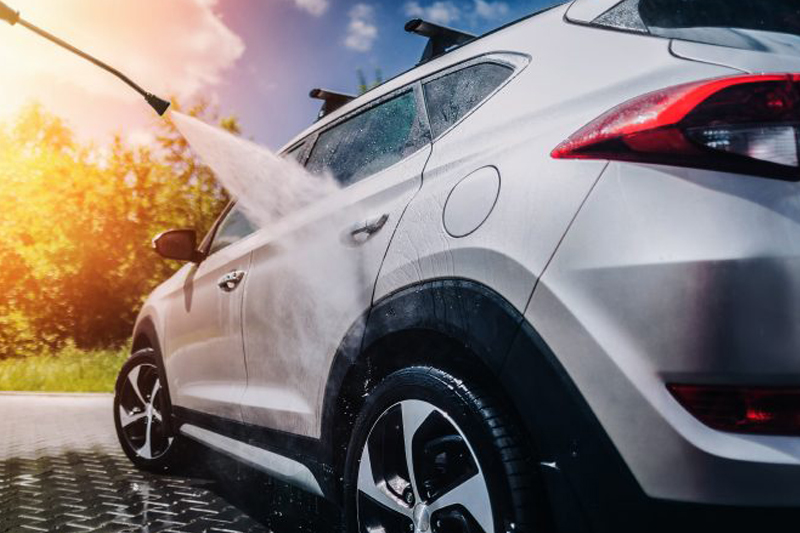
1. Wash the Car
Thoroughly scrub the exterior of your car with soapy water, preferably a soap designed to be used on the exterior of a car. The goal is to remove any loose dirt, mud, and dust. Once your surfaces are washed, rinse them with water.
Wheels
Many car care professionals recommend washing the wheels first, because they are the dirtiest part of the car. Make sure to use a wheel-cleaning solution designed for the type of wheel you have.
Don’t use a stronger wheel cleaner than you have to. Too harsh of a wheel cleanser is hard on your wheels, and all wheel cleaning solutions are hard on your paint job.
Try to keep wheel cleaning solution off the tires. Otherwise it might splatter onto the paint job when the vehicle is in motion.
Body
Use a car washing mitt or microfiber towel, making sure to soak it periodically in the water bucket so you aren’t just taking the dirt you scrubbed off and putting it right back on.
Can I Wash My Car with Hand-Dishwashing Soap?
Dishwashing soap is a degreasing agent. This can be good for getting sticky grease, dirt, and old wax off your car surfaces.
However, it also degreases the oil in your car’s paint job and undermines the wax job you are about to do. In general, using hand dish washing soap to wash your car will degrade your car’s paint job and is not recommended.
Windows
Scrub your windows and glass surfaces with a glass cleaner and a rag or sheet of newspaper. Tough streaks? Get in there with some “elbow grease” to get it off.
Can I Wash My Car Windows with Windex?
In general, yes. Window glass is window glass. However, Windex is not good for tinted windows. Windex contains ammonia, which can strip away the tinting. Use a tint-safe window cleaner for any tinted glass surfaces.
2. Prepare the surface
Now that the car is washed, it will be easier to see blemishes like swirls, scratches, or oxidation of the paint that you can address with polish.
We’re not there yet, though. Go over the paint surface with the palm of your hand. You may be shocked to discover lumps and grains of dirt and other contaminants that have burrowed into your clear coat. A good detailing job will address this embedded dirt as well.
“Plucking the Finish”
The best way to get rid of these deep-seated blemishes is with a bar of automotive clay, often sold in kits with lubricating spray.
Spray the surface with claying lubricant (no more than two feet by two feet). Flatten a piece of the synthetic clay into a patty against your hand and rub it against the lubricated surface. You will feel it stick as the clay grabs contaminants. When it rubs smoothly over the surface, it has collected all the contaminants and you can move on.
Fold and flatten the clay as often as needed. Once the clay turns gray, consider discarding it and using a new piece.
3. Polish
Polishing is not the same as waxing. Whereas wax protects the whole paint job, polishing addresses imperfections on the paint job like swirls, scratches, and oxidation. An automotive polisher is expensive and time-consuming to use, but if you really want your car to dazzle, don’t skip this step!
Apply polish to the polisher’s pad and rub it on the vehicle over two-foot-by-two-foot area. Using a high speed gets the job done quicker, but a slow speed results in the most even, thorough polish.
4. Wax
Applying a layer of paste-like wax to your car’s exterior protects the paint job and makes the car seem to glow. Apply the thinnest coat of wax possible.
Do not wax your car in the sun, or it might dry too quickly and unevenly. Also, only wax a dry car. Water droplets cause wax streaks which take forever to buff away.
Carnauba or Synthetic?
Carnauba wax, derived from Brazilian palm trees, are the go-to for most waxing jobs. Natural and affordable, it dresses your car up with a warm, deep shine. Some people prefer synthetic waxes, especially pricier polymer-based waxes, for the wet-gloss, high-mirror shine they are capable of producing.
5. Engine
Why bother, right? No one sees the engine of the car except mechanics. As long as it runs, what does it matter if it gets dirty?
Leave aside for a moment the fact that mechanics love working in a clean engine. If you plan to sell the car, your buyer will almost certainly look under the hood. If the engine looks like it just survived World War II, you may not be able to command the same high price as you would if the engine was in good cosmetic condition.
Spray the engine lightly with hose water, then apply a degreaser. Consider a water- or citrus-based degreaser. Petroleum-based degreaser works quickly but beat up rubber seals and hoses. Cover your fender so the degreaser does not eat away at the paint job.
Don’t let your engine air dry. Wipe it down with a microfiber cloth, especially rubber components that could crack.
6. Interior
Once the exterior of your car is clean, it’s time to focus on the interior.
Clean Out Junk
Many people use their cars as mobile suitcases or storage lockers. Cleaning all the debris out of the back seat and trunk may go a long way toward making your car look better.
Vacuum
Use a portable vacuum cleaner to remove dust and small debris from the carpet and upholstery. Make sure to slide the seats forward to clean underneath.
Deodorize
If your car smells of cigarette smoke, lightly spray the surfaces with aerosol Dakota Non-Smoke. Then turn the car on, set the fan to recirculate mode and turn it on high. Hold a tissue near the blower motor until you find the intake opening. Then spray Dakota Non-Smoke into this opening.
Seal the car for at least an hour. The baby powder smell will dissipate. Consider changing your air filter after this treatment.
Clean Leather
Get an interior leather cleaning kit. Apply leather cleaner and protectant cream to all leather surfaces. If the leather has been stained by ink, makeup, or clothing dye, spot-treat the stain with leather conditioner, apply leather-safe ink-lifter, let sit for thirty minutes, then wipe.
Shampoo Carpet and Upholstery
Consider investing in, renting, or borrowing a carpet-cleaning machine. The deep-cleaning shampoo it sprays on your cloth surfaces lifts deep-seated dirt and sucks it into a reservoir, from whence it can be scrubbed out of your life with a brush.
Pro Tips for DIY Car Washing
Here are some “hacks” to make your DIY car detail go more smoothly and last longer …
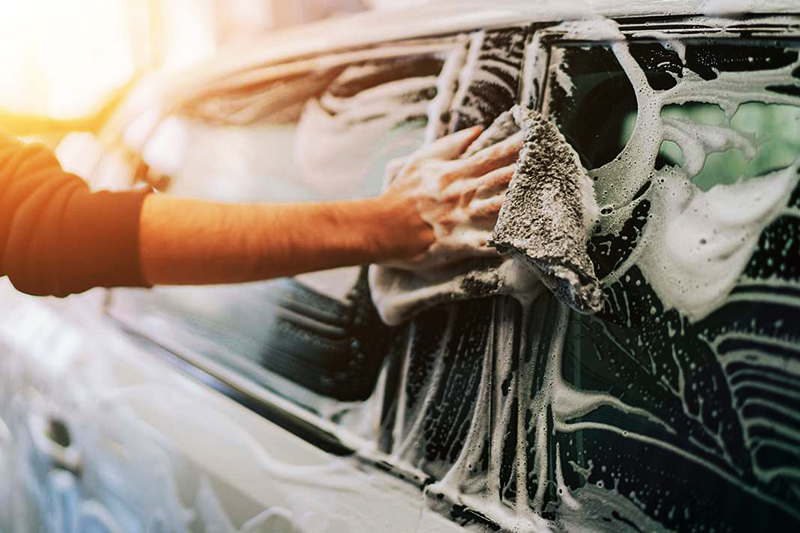
Raid Your Kitchen and Bathroom for Car Cleaning Products
With all the specialized cleaning products this guide put your shopping list, simply taking the car to a professional detailer may seem like the less pricey option.
Most of these products can be bought in quantity to last multiple washes, but certain household mainstays—both cleaning products and food products—may be surprisingly useful in your DIY auto detailing journey. See if you have any of the following lying around …
Cooking Spray
Break out the nonstick cooking spray—yes, the stuff you use to keep eggs and pancakes from sticking to your pan. Spray some on your wheels as an easy way to loosen and wipe off brake dust.
Cooking spray is also useful to loosen the guts of smashed bugs from your windshield.
Mayonnaise
Tar stain on your exterior? Don’t hold the mayo. Put a few spoonfuls of mayonnaise on a rag and rub the tasty condiment on the tar stain until it is completely covered. Wait 5-10 minutes, then wipe it off with a clean rag.
Cola
Fizzy soda pop is a great DIY solution to clean a grimy windshield, especially after a rainstorm. Cover your windshield with the carbonated beverage and let the bubbles break up the grease. Wash away the cola thoroughly to avoid stickiness that will ultimately attract more grime.
Baby Wipes
Baby wipes are also effective windshield cleaners, no rinsing required. Store them in the glove compartment.
Hair Conditioner
If your hair conditioner contains lanolin, it could be just what you need to polish your chrome surfaces. Give it a quick polish with hair conditioner and then wipe away the excess for a dazzling mirror finish to your chrome.
Ammonia
If you don’t have window cleaning fluid, the household cleaner ammonia can do the job. Dilute 60 mL of ammonia into one liter of water. Remember, don’t use ammonia on tinted glass.
White Vinegar
Full-strength white vinegar is a pungent but natural and non-toxic cleaner. Soak a cloth with white vinegar and use them to wipe down your windshield wipers. This will make them sparkle and help them run effectively, especially after a rainstorm.
White vinegar is also great for removing bumper stickers (see below).
Bottle Your Cleaners and Bring Them Along for Touch-Ups
Whether you use commercial, consumer, or homemade cleaning products, store a few of your favorites in bottles and jars in your trunk, along with a few microfiber rags.
If you notice a wheel, window, or chrome surface look a little worse for wear, give them a quick buff. Nothing makes a car detailing job easier like an ounce of prevention!
How to Remove Bumper Stickers
Tired of looking at that old bumper sticker for a candidate you regret supporting? White vinegar to the rescue.
Soak the bumper sticker in white vinegar and let it sit for 10-15 minutes. Then scrape the sticker off with a credit card and use more vinegar to wipe away any excess adhesive residue.
How to Restore and Clean your License Plate
To remove surface rust and prevent it from recurring, spray your license plate with WD40 lubricant. Wipe the license plate with a clean rag.
How to Remove Rust from Chrome Surfaces
Time to break out the cola again. Dip a crinkled piece of aluminum foil into cola and use it to scrape away rust spots on your chrome surfaces.
How to Clean your Headlights
Clean headlights are an important safety feature. To keep them glowing, spray the surfaces with window cleaner (Windex is fine) and then wipe them down with a clean microfiber clothe.
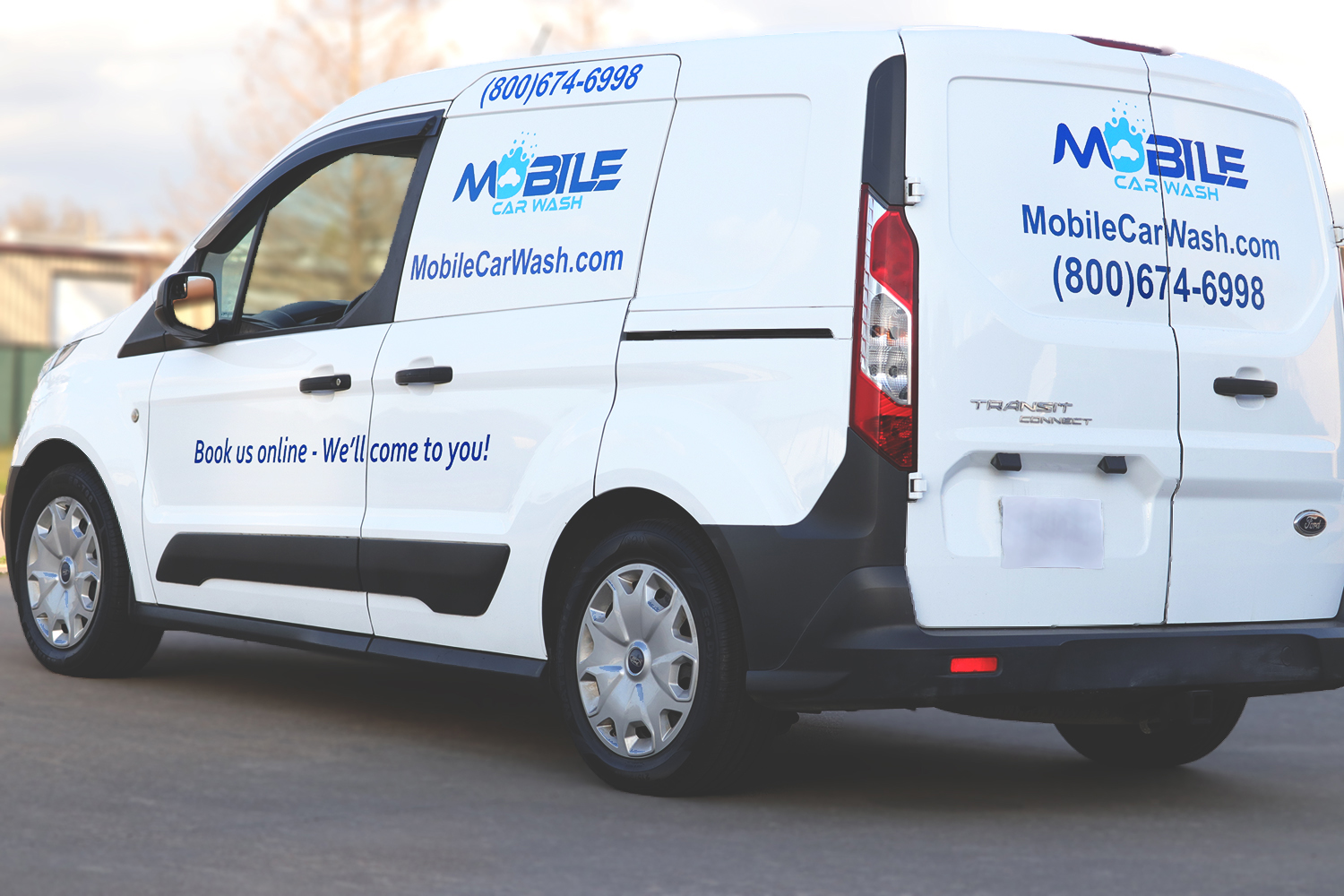
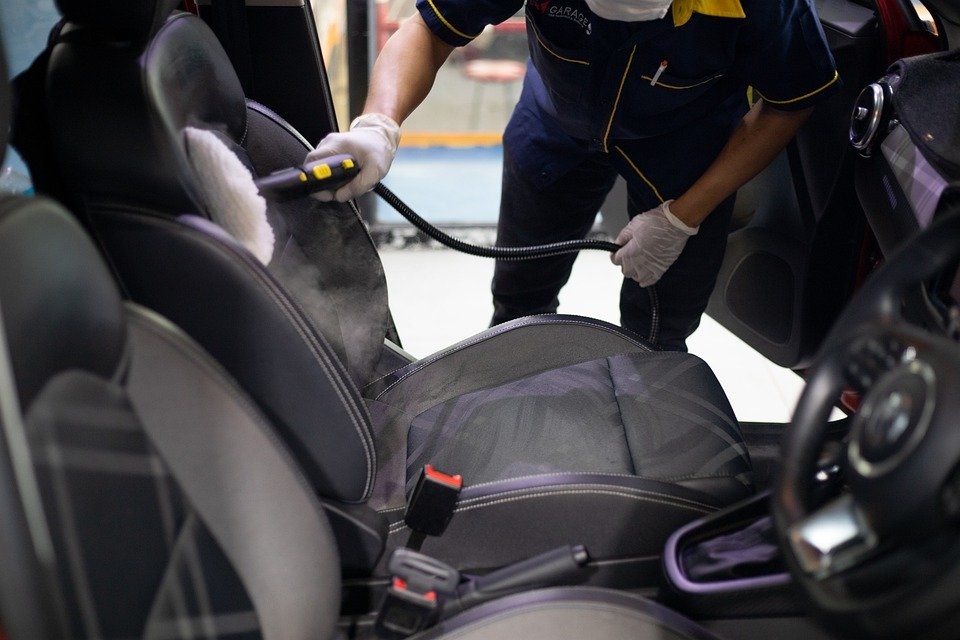

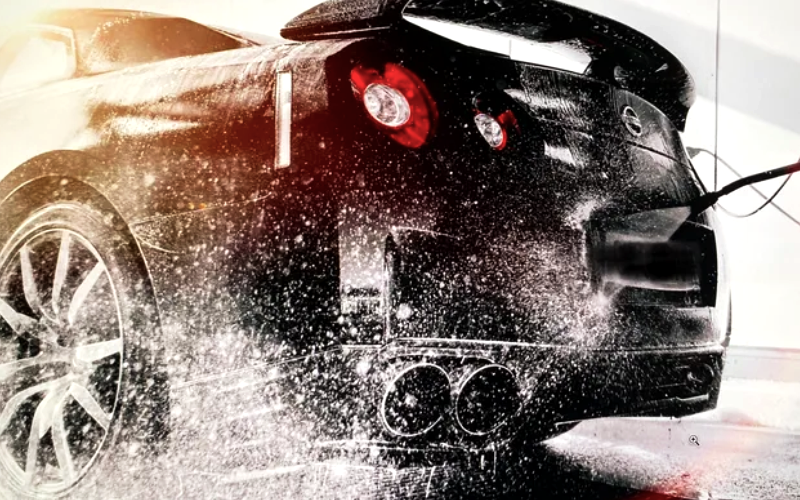
Josh
7 Feb 2020Hello,
Where are you located?
Bill
9 Feb 2020Thank you for sharing this. I am in the auto detailing business and there are always something new to learn. Many times a customer will not know the difference from a simple car wash to a car detailing service.
It can be somewhat troublesome if you’ll keep having to explain the differences. After writing that, I think I’m going to print out a big sign and hang it up in our lobby are!